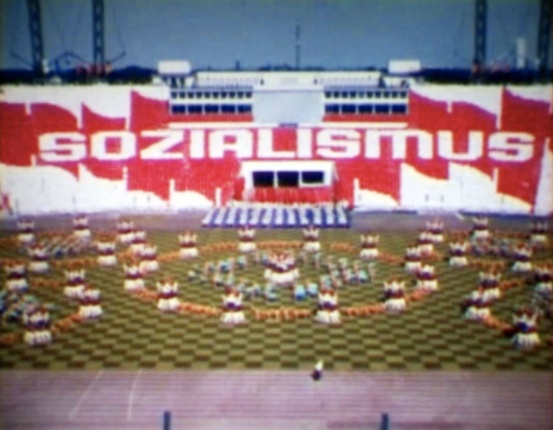This exhibition takes its title from the German word ostalgie, a term that emerged in the 1990s to describe a sense of longing and nostalgia for the era before the collapse of the Communist Bloc.
“Ostalgia,” 2011. Exhibition view: New Museum. Photo: Benoit Pailley
Lobby, Lobby Gallery, Second Floor, Third Floor, Fourth Floor, and Fifth Floor Visit Us
Interested in learning more? Download the audio guide
Twenty years ago—after the fall of the Berlin Wall—a process of dissolution led to the breakup of the Soviet Union and many other countries that had been united under Communist governments. From the Baltic republics to the Balkans, from Central Europe to Central Asia, entire regions and nations were reconfigured, their constitutions rewritten, their borders redrawn. “Ostalgia” looks at the art produced in and about some of these countries, many of which did not formally exist two decades ago. Mixing private confessions and collective traumas, the exhibition traces a psychological landscape in which individuals and entire societies must negotiate new relationships to history, geography, and ideology.
 Nikolay Bakharev, #14 from the “Relationship” series, 1989. Gelatin silver print 11 3/8 in x 11 3/8 in (29 × 29 cm). Courtesy the artist and Gallery.Photographer.ru, Moscow
Nikolay Bakharev, #14 from the “Relationship” series, 1989. Gelatin silver print 11 3/8 in x 11 3/8 in (29 × 29 cm). Courtesy the artist and Gallery.Photographer.ru, Moscow
“Ostalgia” brings together the work of more than fifty artists from twenty countries across Eastern Europe and the former Soviet Republics. Many of the works offer a series of reportages on aspects of life and art under Communism and in the new post-Soviet countries. The exhibition pays particular attention to the unique place that artists came to occupy in Socialist countries, acting simultaneously as outcasts, visionaries, and witnesses. Unlike a conventional geographical survey, the exhibition includes works produced by Western European artists who have grappled with the reality and the myth of the East. Some of the preoccupations that unite the artists in “Ostalgia” are a romantic belief in the power of art as a transformative, almost curative agent; an obsession with language; the conception of a new aesthetic of the body; a fascination with the ruins of history as represented by monuments and architectural vestiges; and an understanding of artwork as a form of sentimental documentary that mediates between cultural pressures and individual anxieties.
Combining seminal figures and younger artists, “Ostalgia” does not follow a chronological perspective, establishing instead a series of dialogues between different generations and geographies. Zigzagging across distant cultural landscapes, the exhibition exposes local avant-garde practices and highlights international affinities, which indirectly question the centrality of Western art historical paradigms.
“Ostalgia” is curated by Massimiliano Gioni, Associate Director and Director of Exhibitions, with Jarrett Gregory, Assistant Curator. Extended labels by Chris Wiley.
 Andrei Monastyrski, Slogan, 1977, at Governors Island, New York, 2011. Photo: Naho Kubota
Andrei Monastyrski, Slogan, 1977, at Governors Island, New York, 2011. Photo: Naho Kubota
Governors Island Installation by Andrei Monastyrski
Andrei Monastyrski is the founder of the Moscow-based artist group Collective Actions. This loose association of artists was founded in 1976 and practiced a brand of conceptualism which made use of poetic language and simple performative gestures. Monastyrski and his collaborators (Nikolai Panitkov, Igor Makarevich, Elena Elagina, Sabine Hänsgen, and Sergei Romashko) organized their works clandestinely with a limited audience that was actively involved in the creation of the work. In a typical Collective Actions event, a small group of viewers would be invited to travel to an isolated location on the outskirts of Moscow. There they would encounter a variety of mysterious actions and objects which made use of the surrounding landscape to activate the viewer’s experience of the site. Possible events could include a man walking through an empty field and falling into a pit, the sound of single ringing bell, or the presentation of enigmatic messages on banners hung from trees. For Monastyrski and his collaborators, the work extended beyond the event itself to include the duration of the viewer’s journey and the persistence of the event in memory and written descriptions. Collective Actions adopted a distinctly romantic approach in which their strange slogans became captions transforming the landscape into a real-time film.
For “Ostalgia,” the New Museum re-presented Andrei Monastyrski’s work Slogan (1977) on an isolated location on Governors Island from July 14–September 25, 2011. The work consists of a red and white banner, which carries the message in Russian: “I DO NOT COMPLAIN ABOUT ANYTHING AND I ALMOST LIKE IT HERE, ALTHOUGH I HAVE NEVER BEEN HERE BEFORE AND KNOW NOTHING ABOUT THIS PLACE.” Facing the Statue of Liberty, the banner turns into a moving commentary on the history of displacement and relocation that characterizes New York’s harbor. This installation of the work maintains the sense of hermetic discovery inherent in Monastyrski’s original actions while allowing the message to reverberate to an entirely new audience.







